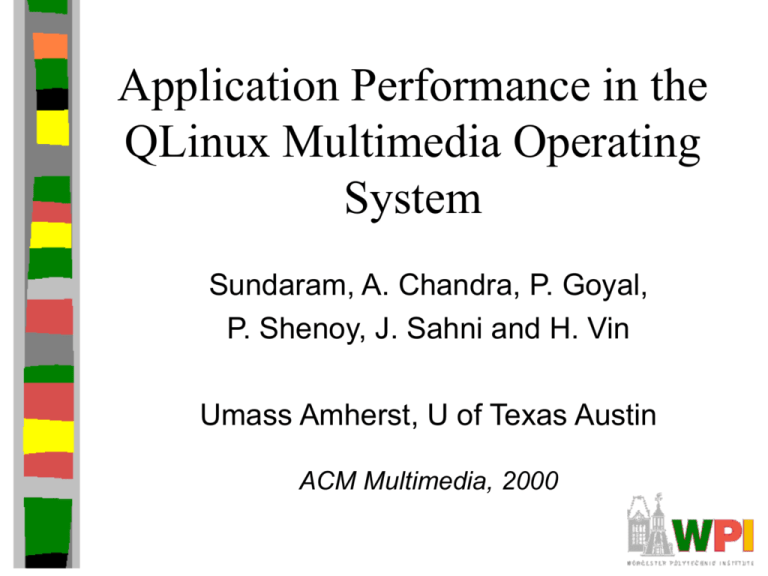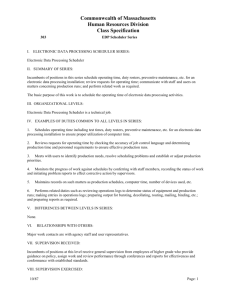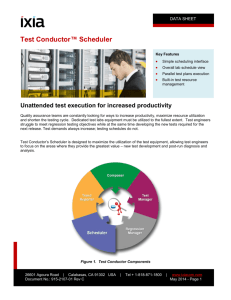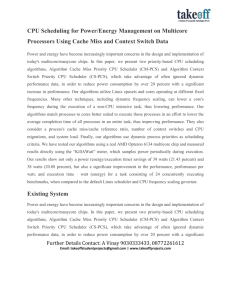ppt - Computer Science
advertisement

Application Performance in the QLinux Multimedia Operating System Sundaram, A. Chandra, P. Goyal, P. Shenoy, J. Sahni and H. Vin Umass Amherst, U of Texas Austin ACM Multimedia, 2000 Introduction • General purpose operating systems handline diverse set of tasks – Conventional best-effort with low response time + Ex: word processor – Throughput intensive applications + Ex: compilation – Soft real-time applications + Ex: streaming media • Many studies show can do one at a time, but when do two or more grossly inadequate – MPEG-2 when compiling has a lot of jitter Introduction • Reason? Lack of service differentiation – Provide ‘best-effort’ to all • Special-purpose operating systems are • similarly inadequate for other mixes Need OS that: – Multiplexes resources in a predictable manner – Service differentiation to meet individual application requirements Solution: QLinux • Solution: QLinux (the Q is for Quality) – Enhance standard Linux – Hierarchical schedulers + classes of applications or individual applications – CPU, Network, Disk Outline • QLinux philosophy • CPU Scheduler – Evaluation • Packet Scheduler – Evaluation • Disk Scheduler – Evaluation • Lazy Receiver Processing – Evaluation • Conclusion QLinux Design Principles • Support for Multiple Service Classes – Interactive, Throughput-Intensive, Soft Real-time – Low average response times, high aggregate throughput, performance guarantees • Predictable Resource Allocation – Priority not enough (starvation of others) – Ex: mpeg_decoder at highest can starve kernel – QLinux uses rate-based rather than priority based + Weight based on rate for each: wi / j wj – Not static partitioning since unused can be used by others QLinux Design Principles • Service Differentiation – – – – Within a class, applications treated differently Uses hierarchical schedulers Top level gives resources to class In each class, can allocate resources appropriately among all applications • Support for Legacy Applications – Support binaries of all existing applications (no special system calls required) – No worse performance (but may be better) QLinux Design Principles • Proper Accounting of Resource Usage – Application level CPU easy – Kernel resources hard + Load from interrupts difficult to charge to process + Many kernel tasks are system-wide – Lazy receiver processing + Defer packet processing when receiver asks – CPU scheduler allocation holds even when kernel uses up various amounts of CPU QLinux Components Hierarchical Start-time Fair Queuing (H-SFQ) CPU Scheduler • • • • (Typical OS?) Uses a tree Each thread belongs to 1 leaf Each leaf is an application class Weights are of parent class • • Each node has own scheduler Uses Start-Time Fair Queuing at top for time for each H-SFQ CPU Scheduler • Nodes can be created on the fly • Threads can move from node to node • Defaults to top-level fair scheduler if not • specified Utilities to do external from application Allow support of legacy apps without modifying source Experimental Setup (for all) • Cluster of PCs – – – – P2-350 MHz 64 MB RAM RedHat 6.1 QLinux based on Linux 2.2.0 • Network – 100 Mb/s 3-Com Ethernet – 3Com Superstack II switch (100 Mb/s) • “Assume” machines and net lightly loaded Experimental Workloads • • • • • • • Inf: executes infinite loop – Compute-intensive, Best effort Mpeg_play: Berkeley MPEG-1 decoder – Compute-intensive, Soft real-time Apache Web Server and Client – I/O intensive, Best effort Streaming media server – I/O intensive, Soft real-time Net_Inf: send UDP as fast as possible – I/O instensive, Best effort Dhrystone: measure CPU performance – Compute-instensive, Best effort Lmbench: measure I/O, cache, memory … perf CPU Scheduler Evaluation-1 • Two classes, run Inf for each • Assign weights to each (ex: 1:1, 1:2, 1:4) • Count the number of loops CPU Scheduler Evaluation-1 Results “count” is proportional to CPU bandwidth allocated CPU Scheduler Evaluation-2 • Two classes, equal weights (1:1) • Run two Inf • Suspend one at t=250 seconds • Restart at t=330 seconds • Note count CPU Scheduler Evaluation-2 Results (Counts twice as fast when other suspended) CPU Scheduler Evaluation-3 • Two classes: soft real-time & best effort (1:1) • Run: – MPEG_PLAY in real-time (1.49 Mbps) – Dhrystone in best effort • Increase Dhrystone’s from 1 to 2 to 3 … – Note MPEG bandwidth • Re-run experiment with Vanilla Linux CPU Scheduler Evaluation-3 Results CPU Scheduler Evaluation-4 • Explore another best-effort case • Run two Web servers (representing, say 2 • • different domains) Have clients generate many requests See if CPU bandwidth allocation is proportional CPU Scheduler Evaluation-4 Results CPU Scheduler Overhead Evaluation • Scheduler takes some overhead since • • recursively called Run Inf at increasing depth in scheduler hierarchy tree Record count for 300 seconds CPU Scheduler Overhead Evaluation Results QLinux Components H-SFQ Packet Scheduler • Typical OS uses FIFO scheduler for outgoing packets Use H-SFQ (Fair Queue) to schedule Each leaf is one or more queues of packets • • • Weights for • queues Unused bandwidth to others H-SFQ Packet Scheduler • Operations on the fly • Associate with queue via setsockopt() Packet Scheduler Evaluation-1 • Two classes using Net_inf • Run two receivers to count received packets • 8KB packets Packet Scheduler Evaluation-1 Results (Different packets sizes?) Packet Scheduler Evaluation-2 Results Packet Scheduler Evaluation-3 • Real-world applicatis • Streaming media server in soft real-time class • Increasing number of Net_inf apps • Compare QLinux with Vanilla Linux Packet Scheduler Evaluation-3 Results (Me … note, degradation not linear) Packet Scheduler Overhead Evaluation Results Combined Packet and Scheduler Evaluation • Web server and several I/O intensive apps • Two classes in CPU and Packet scheduler – Web server in one – All I/O intensive Net_inf in other • Web server driven by trace (ClarkNet) • Increase number of Net_inf • Compare to Vanilla Linux Packet/CPU Evaluation Results Qlinux degrades at 8 … ideas why? QLinux Components Cello Disk Scheduler • Typical OS uses SCAN for disk • Cello 2 levels: class independ, class specific • 3 classes • Class specific • • decides when and how many to move Class ind puts where Lastly moved FCFS (Badri’s thesis) Cello Disk Scheduler Evaluation • (None in this paper) • (Previous paper at SIGMetrics) QLinux Components Lazy Receiver Processing (LRP) • Process A running • Packet arrives for process B – Interrupt, IP, TCP, Enqueue gets charged to A! • LRP postpones until process does a read • Tricky! Some steps, e.g. TCP ack, requires it to happen right away – Special thread for each process for packets • QLinux uses special queues, decodes only as far as needed – Special queue for ICMP, ARP … LRP Evaluation and Results • Run 2 Apache Web Servers – Lightly loaded, retrieve 2KB file in 51ms • Bombard 1 server with DoS by sending 300 requests/sec – Other server load went to 70ms • Re-run with Vanilla Linux – Other server load went to 80ms QLinux Total System Evaluation • Run lmbench – – – – – System call overhead Context switch times Network I/O File I/O Memory perofrmance • QLinux vs. Vanilla Linux QLinux Total System Evaluation Results •Not much overall. •Context switch overhead, but 100 ms time slice •QLinux untuned, so could be better Conclusion • Qlinux provides – – – – CPU scheduler Packet scheduler Disk scheduler Proper I/O processing • Provide fair and predictable allocation • Multimedia and Web applications can benefit • Overhead is low • All conventional operating systems should incorporate Future Work • Disk scheduler results • Multiprocessors • Fair allocation of other I/O interrupts • Other devices since Cello disk specific – RAID, tape, Evaluation of Science? • Category of Paper • Science Evaluation (1-10)? • Space devoted to Experiments?








